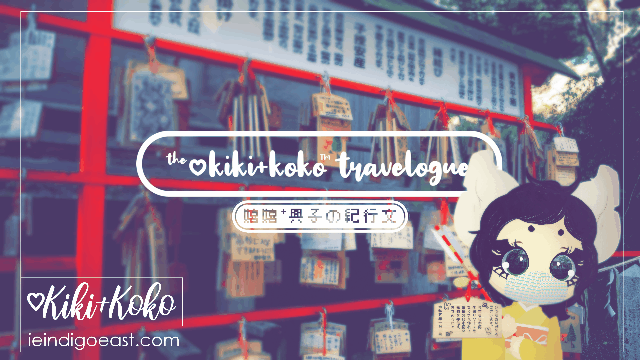 皆様, こんにちにゃあぁ!Welcome to Kiki+Koko: Let’s NihonGO!! Online, your destination for Japanese language and culture lessons. We’re your hosts, Kiki and Koko! Though, we usually promote a more lax environment, not bound by classroom walls, a place tailored to your individual study, we also realise that most everyone at one point or another will find themselves in a classroom—most for quite a few hours a day! And, a huge part of learning is exposure which comes with encounters and opportunities which aren’t always thrown your way. Sometimes, you have to create opportunities based on your own environment. Well, you don’t have to create these opportunities completely on your own. This lesson, we continue to help you expand your vocabulary and learning opportunities with the BーSIDE of this Japanese language learning mixtape.
皆様, こんにちにゃあぁ!Welcome to Kiki+Koko: Let’s NihonGO!! Online, your destination for Japanese language and culture lessons. We’re your hosts, Kiki and Koko! Though, we usually promote a more lax environment, not bound by classroom walls, a place tailored to your individual study, we also realise that most everyone at one point or another will find themselves in a classroom—most for quite a few hours a day! And, a huge part of learning is exposure which comes with encounters and opportunities which aren’t always thrown your way. Sometimes, you have to create opportunities based on your own environment. Well, you don’t have to create these opportunities completely on your own. This lesson, we continue to help you expand your vocabulary and learning opportunities with the BーSIDE of this Japanese language learning mixtape.
Of course, every classroom will have many various objects and supplies you may encounter, but we wanted to give you a decent list of some nouns you can use day-to-day. For now, a this is a great way to absorb the materials. But, that isn’t to say that you won’t encounter these nouns in places like in your room, at a desk, or in an office. The true method to the madness is in actually using the words. We don’t want to bog you down with too much to memorise at once, so we’re breaking this up into manageable sections, which you don’t have to have completely memorised just yet. In upcoming lessons, we’ll help you really learn these vocabulary words along with helping you to learn how to learn these words and more. This method is technically available right, now, though. We recommend two things other than rote memorisation, and that is identifying objects as often as possible, repeating the words when you encounter them, and returning to be sure you’re pronouncing them correctly; and using them in sentences. Again, in future—the quite very near future—we’ll introduce you to some more vocabulary words from other parts of speech you can use to create sentences.
Rote memory is a method students seem to shy away from, but there is something important about it. Saying, writing, or listening to something over and over again is a tried and true method of learning. However, it is essential to engage in other forms of practise not only for the sake of learning, but for the sake of keeping things fun. There can be something fun and almost meditative about rote memorisation, though. We really think it’s all about mindset and attitude in the end, though.
And, remember, there is no need to rush yourself. Be patient and if you feel yourself hitting a wall with revising / studying, take a break and come back to it. You’ll learn more when your mind is more perceptive to it than if you’re feeling overwhelmed. Incorporating different types of learning into one will definitely make you feel like you are progressing further, as well as learning words that you encounter often. Of course, it’s important to learn as much as possible if your goal is to become fluent, but

This lesson has many useful basic questions, but for lessons on how to make questions as well as question vocabulary, scroll to the question section of grammar page of the Japanese Language Learning Essentialssection.
As for incorporating different types of learning, this lesson not only assists you with listening and visual learning, but it’s also a chance to practise Japanese grammar such as basic sentences and particles~! So, be sure to have a look at the grammar lessons for more learning materials with which to work. We recommend for anyone who has already learnt the very basic of basics and wants to practise some other vocabulary based grammar, you can take a look at our 疑問詞, gimonshi, or question words lessons, which oddly enough will have more lessons in future. But, these several lessons will help you with basic questions and question words that seem simple at first, then seem complicated, but then become simple again when you understand it’s simply something that’s a catch-all for many question words.
Simple Survival Sentence Study
Just in case you may have scrolled past the introduction, we wanted to give a quick and easy way to get to the essential grammar knowledge you need to survive in Japanese language. We recommend the very basics at least, even if you’re just looking to learn useful phrases, as it will give you a bit better understanding in using even basic phrases. Whether you plan to become fluent or just want to dabble, you’ll feel much better and more prepared to learn more Japanese when you have a structure of where certain vocabulary words you learn are meant to go in a sentence.

If you’d like to practise with these nouns, you can always open another tab, window, or device where you have a visual of both the new words and the grammar.
Though knowing the kanji and how to ‘spell’ the words is useful, as well as knowing the romaji input for typing, knowing the pronunciation will help you not simply survive, but thrive! That’s why we have our computer robot friend equip with the latest Heisei era tech, QUIZBO™くん!(The ™ is silent)

Hello, there!僕、 QUIZBO™くんです!教室に関係ある名詞を覚えましょう!Let’s NihonGO!!
If you remember from previous instalments, this is a portable version, QUIZBO™ Mini, who lives here on the site. He’ll be here to help sound out these vocabulary words for you. You can click the sound ‘bytes’ as many times as you’d like, QUIZBO™ won’t mind. ( Get it, bytes? … Computer? …We’ll stick to teaching Japanese. )
You can click the 「▶」button as many times as you like, day or night, and he’ll repeat them. Return when these vocabulary words come to mind so that you can keep your pronunciation in check. Though he’s a robot, he’s quite skilled at speaking human language. He’s lovely with tones, as well, and he will read each mora so you can spell it properly in kana.
Are you ready!? Let’s NihonGO!!
One More Thing Before We Begin:
 There is another very useful vocabulary words we’ve already introduced in another lesson that you would most certainly benefit from. You can learn ‘teacher’ and other honorifics at our honorifics lesson. But, be sure to learn exactly what honorifics are on SIDE-A. The honorific ‘teacher’ can be used on its own when referring to the teacher as well. It’s sort of like in English where students will say ‘Teacher Susan’ or ‘Teacher Dave’ except usually this will be attached to the surname in a way closer to ‘Professor Nakamura’ or ‘Professor Andersson’. A lot of Japanese students will call their ESL teachers ‘Teacher’ in the same way. But, it’s more important to learn how honorifics work in order to understand how to refer to teachers, professors, and even doctors, in Japanese.
There is another very useful vocabulary words we’ve already introduced in another lesson that you would most certainly benefit from. You can learn ‘teacher’ and other honorifics at our honorifics lesson. But, be sure to learn exactly what honorifics are on SIDE-A. The honorific ‘teacher’ can be used on its own when referring to the teacher as well. It’s sort of like in English where students will say ‘Teacher Susan’ or ‘Teacher Dave’ except usually this will be attached to the surname in a way closer to ‘Professor Nakamura’ or ‘Professor Andersson’. A lot of Japanese students will call their ESL teachers ‘Teacher’ in the same way. But, it’s more important to learn how honorifics work in order to understand how to refer to teachers, professors, and even doctors, in Japanese.
Now, let’s begin!
Basic Classroom Vocabulary | 基本的な教室の単語 | Nouns|名詞
Folder (🇺🇸File Folder)
フォルダー【ふぉるだー】forudaa
ファイル【ふぁいる】 fairu
Rubbish Bin / Dust Bin (🇺🇸Trash Can)
ゴミ箱【ごみばこ】 gomibako
ごみ入れ【ごみいれ】 gomiire
Bookcase / Bookshelf
本棚【ほんだな】 hondana
Dictionary
辞書【じしょ】 jisho
辞典【じてん】 jiten
Map
地図【ちず】 chizu
Blackboard
黒板【こくばん】 kokuban
Here’s a quick fun culture fact: As of the time we’re writing this, and presumably for quite a while still after, blackboards are quite widely used in Japan. Whilst smartboards prevail in the West, you can still hear the nostalgic click-clack of chalk on a blackboard in classrooms all over Japan. This is another reason why the general feeling of needing to know how to write by hand isn’t a thing of the past. It’s useful for kinaesthetic learning, and there is just something about a blackboard, taking notes alongside the teacher and racing to write it down before they erase the board that makes you feel alive.
Chalk
チョーク【ちょーく】 chooku
Computer
[Find out from this Word of the Week with QUIZBO™くん]
Calculator
計算機【けいさんき】 keisanki
電卓【てんたく】 dentaku
Scissors
鋏(ハサミ)【はさみ】 hasami
(Measuring) Ruler
定規【じょうぎ】 jougi
Set Square (🇺🇸Triangle)
三角定規【さんかくじょうぎ】sankakujougi
Backpack 🎒
バックパック
There are quite a few ways to call a bag you place your school supplies in. We cover randsell and rucksack in the previous lesson, but we reckoned it important to mention the literal word ‘backpack’. (Again, we’ll speak of ‘randsell’ backpacks in a future lesson.)
Glue
糊【のり】 nori
Not to be confused with 海苔, nori, seaweed. This kind of 糊, nori, is recommended with sushi.
Calendar
カレンダー【かれんだー】 karendaa

Support your kinaesthetic learning along with even more Japanese language and culture lessons in new and more extravagant formats with this notebook and more with this design available at ieindigoeast.redbubble.com
Clock
時計【とけい】 tokei
(Also used for ‘watch’ or ‘timepiece’ in general.)
Lunchbox (🇺🇸Lunch Pail / Lunch Kit)
弁当【べんとう】bentou
弁当箱【べんとうばこ】bentoubako
That concludes TAPEー1 of this tape cassette collection of Japanese language learning. Don’t forget to turn back over to SIDEー A especially when we begin the next part of this section. And, again, try not to overwhelm yourself with too many vocabulary words in one session. We always make sure to provide enough material for you to return again to revise.
Some people learn faster than others, and for the majority, it’s best to take your time. Make it a relaxed and enjoyable experience. Casually reference these at any time of the day in order to make them feel more natural. You don’t have to limit learning to your dedicated study time, and you can dedicate as little or as much time as you need to study. Each word you learn is one more word than you knew before~! Never let being busy keep you from your dreams, and don’t wait for a new year or a new week to improve on your life.
Learning to read and write in Japanese can feel like a big task to take on at first, but if you just take it a few characters a week, you’ll feel yourself progressing bit by bit. You can practise these vocabulary words kinaesthetically by writing them. And, you can practise your reading and pronunciation by keeping tabs or windows open with our Reading and Writing lessons. For those learning with us since the beginning, while we were sure to space them out enough to give you time to study, it’s important to return and keep the characters fresh in your mind. And, besides, there’s nothing wrong with trying to improve your handwriting.
But, maybe you already had been following the lessons since the beginning, but couldn’t catch the latest because you may have lost track of the days of the week or you didn’t get to see when our content is usually, posted, or maybe you just want to start staying in the know, never missing out on anything again as of this moment forward! Stay up to date without even having to look at the calendar by subscribing to the Electronic Mailing List of Tomorrow, today, found usually at the bottom of the site page or the sidebar on desktop. You’ll get the latest tools and resources to surviving in Japanese language in straight to your inbox. That’s articles, videos, podcasts, and more.

Grooving to the content we’re creating? You can leave a TIP in the TIP♡JAR to keep it going!
(Can’t? No worries! The content is free for everyone! We’re just glad you’re here!! Bring friends if you like~!)
Speaking of which, we want to continue to ensure your steps to success in your Japanese language learning goals, whether you want to just learn a bit for fun or become fluent. You can allow us to fulfil our goals of living out our mission to teach Japanese language and culture to Earthlings—whilst living in proper shelter with warmth at the mercy of advertisers— as well as ensure the continuation of the creation of new and even better content by leaving a TIP in the TIP♡JAR to keep it going. But! You can also support the content when you purchase any artwork from ieindigoeast.redbubble.com (making sure to use our special redbubble link). But, if there’s something that isn’t from our theme, you can always drop Indigo East a ‘Bubblemail’ if you want to specify that you would like it to go towards this content. Or for long or even short term contributions, you can join our Patreon where our gracious host, Indigo East, usually posts behind-the-scenes, sneak-peeks, exclusive content, and more. And, we join in as well! Again, if you’d like to support our survival and the creation of more content to be made available to as many people as possible, you can also share the content! You can easily share via Twitter and Pinterest where you can retweet and repin respectively without even having to type! Gestures like that go a long way, and we appreciate it. We just want to do our best to fulfil our mission.
Thank you for joining us! We hope that you continue with us on this adventure, and we appreciate that you’ve chosen us to assist you on your Japanese learning journey.






Follow SpeRaToBo || ieindigoeast on WordPress.com






























7 replies »